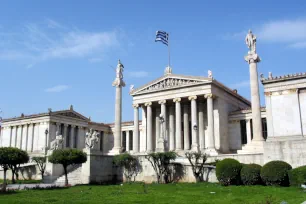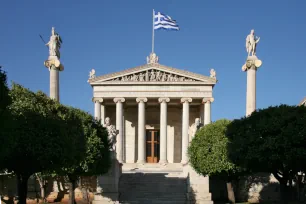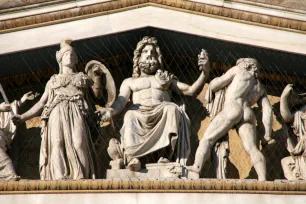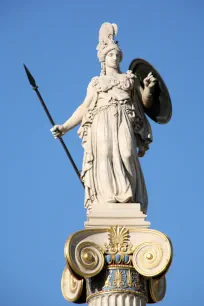The Academy is the most magnificent of all the neoclassical buildings that were constructed in Athens during the 19th century. Its design was inspired by the ancient Erechtheion at the Acropolis.


In the early nineteenth century, Athens was a relatively small town with narrow streets clustered around the historic ruins of the antiquity.
When Greece regained its independence in 1832, Athens was proclaimed capital of the new state and the city embarked on a construction frenzy so it could house all the newly created institutions, including a university, a library, a national bank, a parliament and even a palace. One of the most impressive buildings that were erected during this era was the Academy of Athens, the home of Greece’s national academy.
Construction
The building was designed by Theophil Hansen, a Danish/Austrian architect with a classical training. Hansen had previously worked on the University Building with his brother Christian and he would later also design the National Library. These three buildings, all built next to each other, form the so-called Athenian Trilogy.
The Academy is the most acclaimed of the three buildings. It was constructed in pentelic marble between 1859 and 1885 under the supervision of architect Ernst Ziller, a student of Hansen. The wealthy businessman Simon Sinas, founder of the National Bank of Austria and Greek Consul in Vienna, provided the necessary funds.
Design

The building consists of a central amphiprostyle temple (ie it has a front and back portico) connected by a colonnade to two wings, each with a neoclassical temple. The design of the central temple, with a large Ionic portico, was based on the east side of the classical Erechtheion at the Acropolis. The relief sculptures in the tympanum were created by Leonidas Drosis. They are an interpretation of the famous statues of the Parthenon and symbolize the birth of goddess Athena.

The interior is decorated with eight large murals, painted by the German artist Christian Griepenkerl. They depict the myth of Prometheus, who stole fire from Zeus and gave it to mortals. During the War of Independence in the early nineteenth century, the mythological figure of Prometheus inspired the revolutionaries.
Flanking the main temple are two tall Ionic columns with statues of Athena and Apollo. Athena, Greek goddess of wisdom, arts, civilization, warfare and justice is shown dressed in armor, holding a shield and a spear. Apollo, god of music and poetry, is depicted holding a lyre in his left hand. Both statues were sculpted by Leonidas Drosis.
The same sculptor created two more statues, situated on either side of a staircase leading to the Academy. They depict the famous Greek philosophers Plato and Socrates, who are shown seated.
- Next: Kerameikos
- More Sights & Attractions in Athens

